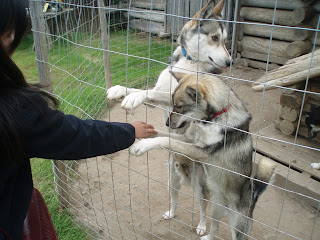 |
Image via Tom Häkkinen
Viewed from the bus travelling North through Finland. The
sun is clearing away the early morning fog. |
Who doesn’t fantasise about the far North? I mean the real far North, the inhospitable, wild North. Obviously my
Finnish roots might have had some role to play in my own fascination with the North, but I’m sure I’m not the only one. A few years ago my dad accomplished a life-long ambition by travelling to
Nordkapp in Norway, the Northern-most tip of Europe, where, in summer-time you can look-out at the vast expanse of the
Arctic Ocean and watch as the sun circles ceaselessly around the sky without ever dropping below the horizon. Of course, I wander along the nearby cliff-walk occasionally and get to stare in awe at the vast Pacific Ocean, but it’s not the same, it’s not the alien, otherworldly ocean that sits at the top of the world.
Last year, I didn’t go near so far North as Nordkapp, in fact, I didn’t even go so far as
Utsjoki, the northernmost part of Finland, but I did reach a certain milestone in Latitude, and I went further North than my brother from Norway had ever been, and further North than any of my friends from Canada. I crossed the
Arctic Circle.
 |
Image via Tom Häkkinen
Reindeer or Poroa eating Birch leaves in Ranua. |
This is quite far North, to give my readers some perspective, imagine travelling to
Montréal and from there driving straight North and not stopping until you reach the sea. If you were to do so, you still wouldn’t reach the Arctic Circle. That’s right, the entire province of
Québec lies south of the Arctic Circle; in fact the only Canadian Provinces or Territories that touch the Arctic Circle are Nunavat, the
Northwest Territories and Yukon.
But maybe that’s an unfair comparison. Thanks to the moderating effects of the
Gulf Stream, the Arctic Circle in Europe and the Arctic Circle in North America are two completely different places. You might be surprised to learn that trees grow in Finland at the Arctic Circle. What’s more there are farms, the roads have the cutest little bus shelters you’re ever likely to see and in the town of
Rovaniemi there are two Universities and a factory that makes expensive knives. In fact the town of Rovaniemi is a real gem, with all of the workshops and industry up there it’s like a veritable Santa’s workshop. Which is kind of fitting, as traditionally Rovaniemi has always been considered the home of Santa Claus.
Except in America.
 |
Image via Tom Häkkinen
Esther patting Siberian Huskies in Santa's Village,
Rovaniemi. In winter you can go for rides on a sled pulled
by a team of Siberian Huskies. |
Which is a shame, because the
Santa’s Village up there could really do with some American “jazzing up”. Finns don’t really do tourism particularly well. Maybe they don’t consider it real work, or maybe it’s just their laconic nature which isn’t particularly suited to selling things generally, but if you’d been to Finland you’d know tourism and the service industry aren’t really the Finnish people’s strongest suit. In fact, even at Linnanmäki, the theme park in Helsinki, you might notice a bizarre phenomenon. Finns don’t scream. Which means from below you can watch roller-coasters going round and round their circuits in a strange surreal sort of silence. Occasionally, one person will start and the rest will generally get the idea, but not always. There’s a reason why
Kimi Räikkönen was nicknamed the
Iceman.
Just to the South of Rovaniemi, in the town of
Ranua, lies the world’s
northernmost zoo. It’s definitely worth a visit, as, if you’re a city person like Esther and I are, then it’s most likely you’ll travel through the North with only the most fleeting glimpses of the strange Northern creatures that inhabit the
Arctic region. I found that visiting a zoo compensated for my lack of outdoors ability and allowed me to take some photos to show everyone back home that I really had been to the furthest extremes of the Earth.
Well, nearly.




